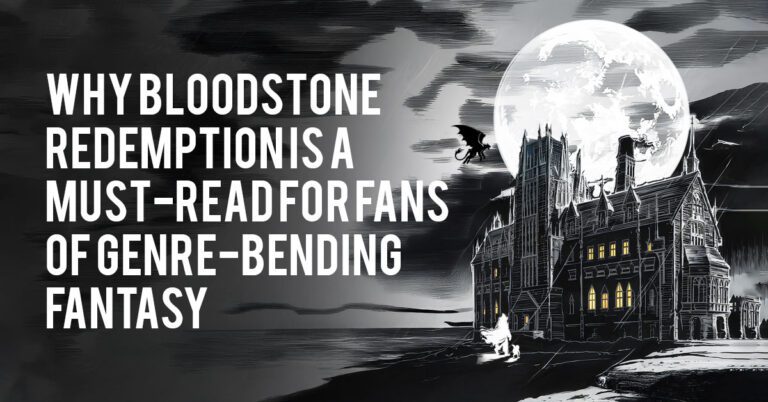In a literary era where fantasy readers crave more than sword fights and dragon-slaying, Eric Carver’s Bloodstone Redemption offers a gripping, genre-smashing adventure that doesn’t just entertain, it interrogates. It blends dark fantasy, urban satire, supernatural horror, and speculative metaphysics into a wildly original novel. But what truly sets it apart isn’t just its magic, it’s the brutal honesty with which it explores human society through the eyes of a powerful outsider.
At the center of this inventive epic is a wizard known only as “Master,” a former god-king exiled from his world and thrown into the madness of modern Earth. What begins as a tale of vengeance soon turns into a twisted journey of reflection, discovery, and reluctant moral evolution.
Technology as Modern Magic: The Totems of “Seer-E” and “Goo-Gull”
One of the book’s most brilliant and darkly comedic observations comes when the Master encounters what we know as smartphones, objects he interprets as mystical “totems.” After witnessing a woman ecstatically dancing with her glowing rectangle, he learns that the device is called an “eye fone” and that its owners can summon knowledge from minor deities known as Seer-E and Goo-Gull (clever jabs at Siri and Google, .
To the Master, these totems are not mere tools; they are artifacts of worship, objects that allow humans to outsource thought, decision-making, and even spirituality. He’s baffled by the idea that people no longer seek knowledge from sages, books, or divine rites, but instead turn to algorithms and artificial voices for truth. He quickly vows to obtain one for himself, not to blend in, but to interrogate these “deities” with his endless questions.
Through this lens, Carver satirizes our dependence on technology and the illusion of omniscience it provides. It’s a hilarious, poignant commentary on how we’ve replaced ancient wisdom with digital convenience, and how alien that might seem to a being from a truly magical world.
Daemonic Campaigns as Social Satire
What makes Bloodstone Redemption particularly brilliant is how the Master’s magical campaigns double as biting social critique. His operations are not large-scale wars, but targeted, symbolic strikes meant to destabilize society’s illusions of control. For example, in one campaign, he and Malodorous steal full-grown lions and tigers from zoos, not for cruelty, but to harvest biological components for anti-aircraft spells. The public, ironically, is more outraged about the missing animals than earlier acts involving desecrated churches or destroyed government property. The Master muses on this misplaced outrage, subtly highlighting society’s skewed priorities and media-driven empathy.
In another “different campaign,” the daemons, bored and restless, are dispatched to burn drug labs, eliminating traffickers and “innocent noncombatants” alike. Though these actions are never officially claimed, public speculation pins the blame squarely on the Master and his allies. The commentary is sharp: a society that mourns the lack of cheap drugs but ignores deeper spiritual or moral decay is, in his view, unworthy of salvation.
These campaigns aren’t just magical, they’re metaphorical. Each act of destruction or subversion forces Earth’s citizens to reckon with the very institutions they take for granted, from governments and religions to media and even elections.
Humanity in the Face of Horror
What prevents the novel from descending into nihilism is its surprising emotional depth. Characters like Dr. Janice Howard, the compassionate physician, and even a few of the “witches” bring moments of clarity and resistance. They challenge the Master not just with words, but with the raw presence of empathy, responsibility, and moral intelligence.
These human interactions spark the Master’s internal shift. He may continue his violent campaign, but he begins to ask questions about redemption, about purpose, about whether ruling or healing is the greater power. The campaign evolves from one of conquest to one of conflicted reflection.
The Daemons as Society’s Echo
The daemons in Bloodstone Redemption aren’t mere monsters; they’re embodiments of primal urges: hunger, greed, vengeance, loyalty. Red 1 and Red 2 grow stronger by consuming not just flesh, but souls, much like how certain societal systems grow by exploiting human weakness. Their evolution mirrors our own institutions: more intelligent, more organized, but always with an undercurrent of self-interest.
Malodorous, meanwhile, reflects what loyalty looks like in a corrupt world, deep, personal, but potentially dangerous. He doesn’t just serve; he enables. He’s a reminder that even support systems can become part of the problem.
The Verdict: A Violent Elegy for Modern Society
Bloodstone Redemption is as much a metaphysical horror story as it is a fantasy adventure. It’s filled with gore and laughs, cruelty and compassion, raw power and poetic justice. But at its core, it’s about society, ours. It asks, through the lens of a displaced god, what happens when you strip away civilization’s illusions. What are we really left with?
It’s a bold, darkly funny, and disturbingly insightful look at humanity’s paradoxes. Whether you’re drawn to high fantasy, philosophical horror, or social satire, this book will leave you in deep thought.

